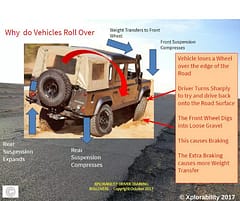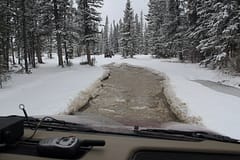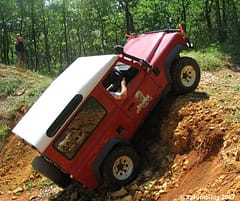Off-Road Rollovers
Why Do They Happen?
Contents
Introduction
Following on from the On-Road Rollover information the same Laws of Motion, Physics and Vehicle Dynamics apply in conjunction with the driver’s experience.
Believe me, there are some very experienced off-road drivers out there who in the “panic” of the moment do forget their basic training. Despite how good we think we are, nobody is perfect all of the time.
Off-Road Rollovers occur on all types of terrain. You can be driving at any speed on a straight track, cornering, ascending or descending hills, traversing side slopes.
Let’s have a look at the most common causes and faults.
This content was developed by and owned by Paul Sinkinson, Xplorability owner. Paul is a 4wd Defensive Driver Training Consultant/Trainer and Programme Developer.

Rollovers on Ascents
When you read our Basic Guide to Off-Road Driving, you will come to understand the techniques for Ascending Hills and the Failed Ascent recovery. You need to find a quiet, safe area to practice them in your vehicle. Take your time until it becomes second nature.
Off-Road Rollovers resulting from “Failed” Hill Climbs
These are usually as a result of the driver panicking when they realise the vehicle is no longer going to make it up the hill. During this panic, the basic recovery instinct is thrown out of the window and they depress the Clutch Pedal to the floor and forget to use the brake. The result of this is that the vehicle immediately rolls backwards. The SPEED that his happens can come as a shock and the laws of gravity take over to the point that the velocity can be terminal. A number of things now join in to make the situation worse.
-
Because the vehicles is going backwards at speed, STILL IN FORWARD GEAR the driver finds that it is impossible to engage REVERSE Gear which may have helped due to the effects from engine braking so, the instinct of self preservation is now to brake excessively to try and slow the vehicle down. When this happens, the wheels lock up and the vehicle starts to slide.
-
It is at this point when the vehicle starts to slide that the driver releases the brake to hopefully stop the slide the natural reaction is then to look over the shoulder to see where the vehicle is going. (Already, the use of the Mirrors when reversing has been forgotten). While looking over the shoulder perhaps now steering with just one hand the driver without realising it turns the steering wheel. As that happens, the vehicle front wheels swing the front of the vehicle sideways across the face of the slope. Because the driver is looking over a shoulder he doesn’t notice that until it is too late and therefore hits the foot brake. This transfers weight to the rear wheels, the front ones become lighter still and the front of the vehicle now slides around across the face of the slope.
-
A Rollover is almost inevitable
Reduce your chance of a rollover on a hill ascent
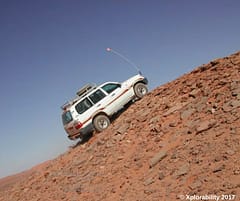
Off-Road Rollovers on Descents
-
If the correct descent procedures and techniques are used then this should reduce the likelihood of a rollover.
-
It is always best to commence a descent from circa two vehicles lengths back from the crest as this allows the engine braking to engage and reduce the vehicle speed before you go “Over the Top.” Not to do so means that the vehicle starts too quickly and perhaps moves one vehicle length down the slope before the engine braking takes effect. When it does engage, that slows the wheels abruptly and they are likely to lock up. With the loss of traction the vehicle will slide.
Reduce your chance of sliding and rolling your vehicle
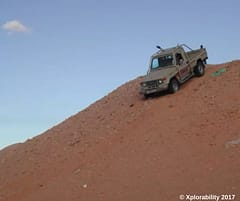
-
As the wheels lock up, the weight transfers to the front wheels inducing a loss of directional control. At the same time, the rear wheels become lighter. IF that happens, the rear of the vehicle may slide around across the face of the slope to an angle so that the weight now transfers to the low side. The upper side of the vehicle is now lighter and at that point the vehicle is likely to rollover.
-
The recognized recovery should the wheels lock up is to gently accelerate to bring the wheel speed up to that of the “gravitational” speed of the sliding vehicle. When that is achieved, directional control should return and allow the driver to continue safely before the vehicle slides sideways. Once control has been established engine braking should be sufficient to control the descent speed.
-
Of course, as they say, “It’s not over until the fat lady sings!” so never be complacent coming down steep hill descents as just when you may think all is going well and you are almost at the bottom of the descent things can still go wrong. Often just as they near the bottom, drivers give themselves a hearty cheer and accelerate and sometimes that can be into serious trouble. As an example, water drains down hill and makes the base boggy. If you enter that area at any speed, the front digs in, the rear becomes light and you can go “base over apex.”
Keep Safe - Exit gently!!!!
Don’t bite off more than you can chew
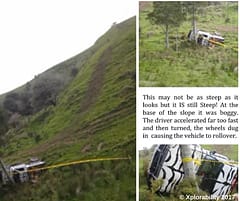
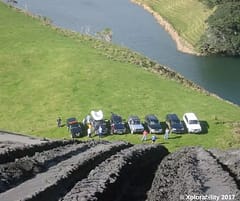
Rollovers on Side Slopes
The “Phenomena” that occurs on Side Slopes just like Yachtsmen – Everybody Leans over!
Both these drivers and their passengers are leaning – their contra action is towards the face of the slope. The Vehicle’s Front Wheels also turn UP the slope increasing the angle.

Picture to highlight the action, the driver has driven over a boulder which again has increased the angle
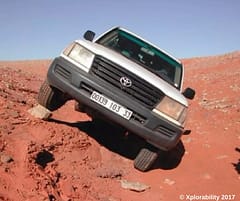
As you can see, his reaction was to contra and the front wheels are steering into the face of the slope. This “Phenomena” causes many rollovers around the world every day. The same would apply if the vehicle’s front wheel had dropped into a hole on the side slope. If both happen at the same time, the angle changes alarmingly.
How can we recover the situation and reduce the likelihood of the vehicle rolling over on a side slope?
IF you find yourself on a Side Angle - Side Slope - Sideline Traverse – There are MANY different names for the situation. (It is safer to keep away from them).
On this obstacle you must concentrate and ensure that you maintain the steering wheel straight – it is difficult to do as the brain and eyes are suggesting otherwise BUT you MUST overcome that – Practice is the KEY! If you start to turn uphill by the “contra,” believe me you WILL feel uncomfortable – The recovery is to turn down the slope (assuming it’s not over the edge of a cliff or into other danger). If, as you are doing that you feel the vehicle slipping then gently accelerate momentarily which will bring the front wheels around and with the weight transferring onto them they will have directional traction. Turn down the slope, straighten the wheel position and drive straight down towards safety. THEN re-assess the situation and if needs be find an alternative route.
Concentrate of what’s happening and Keep Safe.
Previous Article: On-Road Rollovers
Check out other work by Paul, fiction thriller novels here.
Copyright
This content was prepared for the Off-Road Discovery Website by Xplorability 4wd Training
The Content - All Photographs and Photographic Copyright and All other Rights other Reserved October 2017. S.W. France This content may not be copied or reproduced without the written consent of Paul Sinkinson – Xplorability Training.
For Use Only in 4wd and Light Vehicle Driver Training.
Not for Re-Publication, Distribution or use outside the Xplorability Training Programme
